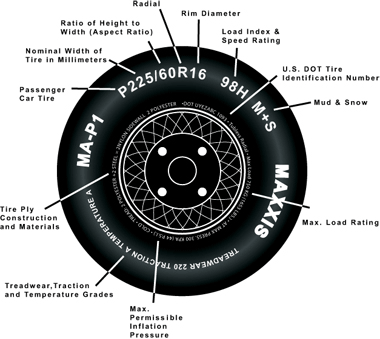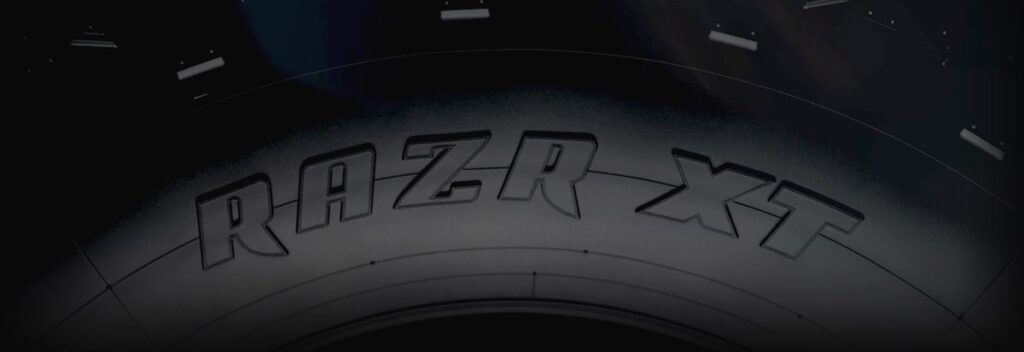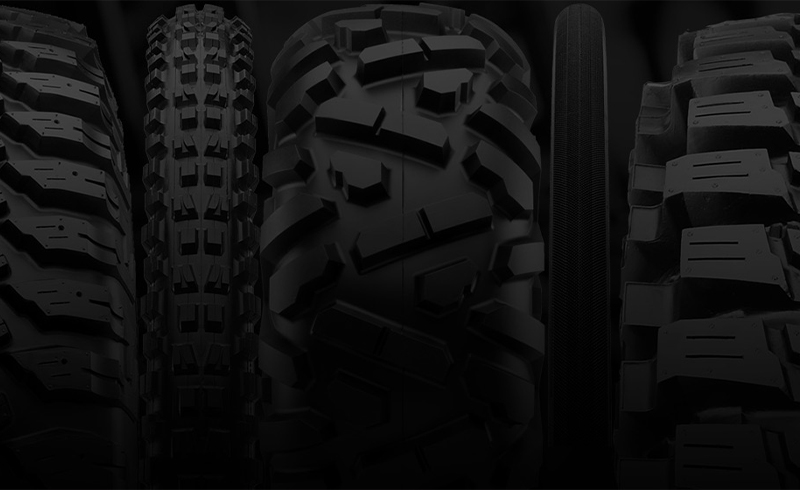Tire Technical Information
Federal law requires tire manufacturers to place standardized information on the sidewall of all tires. This information identifies and describes the fundamental characteristics of the tire and also provides a tire identification number for safety standard certification and in case of a recall.
Tire Sizing




P: Vehicle Type
The “P” indicates the tire is for passenger vehicles.
LT: Vehicle Type The “LT” indicates the tire is for light truck vehicles.
215: Tire Width This three-digit number gives the width in millimeters of the tire from sidewall edge to sidewall edge. In general, the larger the number, the wider the tire.
65: Aspect Ratio This two-digit number, known as the aspect ratio, gives the tire’s ratio of height to width in percentage. Numbers of 70 or lower indicate a smaller sidewall for improved steering response and better overall handling on dry pavement.
R: Radial Ply Construction The “R” stands for radial. Radial ply construction of tires has been the industry standard for the past 20 years.
15: Rim Diameter This two-digit number is the wheel or rim diameter in inches. If you change your wheel size, you will have to purchase new tires to match the new wheel diameter.
95H: Load Index This two or three-digit number is the tire’s load index. It is a measurement of how much weight each tire can support.
| Index | Load (lbs) | Index | Load (lbs) | Index | Load (lbs) |
| 65 | 639 | 94 | 1477 | 123 | 3417 |
| 66 | 661 | 95 | 1521 | 124 | 3527 |
| 67 | 677 | 96 | 1565 | 125 | 3638 |
| 68 | 694 | 97 | 1609 | 126 | 3748 |
| 69 | 716 | 98 | 1653 | 127 | 3858 |
| 70 | 739 | 99 | 1709 | 128 | 3968 |
| 71 | 761 | 100 | 1764 | 129 | 4079 |
| 72 | 783 | 101 | 1819 | 130 | 4189 |
| 73 | 805 | 102 | 1874 | 131 | 4299 |
| 74 | 827 | 103 | 1929 | 132 | 4409 |
| 75 | 853 | 104 | 1984 | 133 | 4541 |
| 76 | 882 | 105 | 2039 | 134 | 4674 |
| 77 | 908 | 106 | 2094 | 135 | 4806 |
| 78 | 937 | 107 | 2149 | 136 | 4938 |
| 79 | 963 | 108 | 2205 | 137 | 5071 |
| 80 | 992 | 109 | 2271 | 138 | 5203 |
| 81 | 1019 | 110 | 2337 | 139 | 5357 |
| 82 | 1047 | 111 | 2403 | 140 | 5512 |
| 83 | 1074 | 112 | 2469 | 141 | 5677 |
| 84 | 1102 | 113 | 2535 | 142 | 5842 |
| 85 | 1135 | 114 | 2601 | 143 | 6008 |
| 86 | 1168 | 115 | 2679 | 144 | 6173 |
| 87 | 1201 | 116 | 2756 | 145 | 6393 |
| 88 | 1235 | 117 | 2833 | 146 | 6614 |
| 89 | 1279 | 118 | 2910 | 147 | 6779 |
| 90 | 1323 | 119 | 2998 | 148 | 6944 |
| 91 | 1356 | 120 | 3086 | 149 | 7165 |
| 92 | 1389 | 121 | 3197 | 150 | 7385 |
| 93 | 1433 | 122 | 3307 | ||
Note: You may not find this information on all tires because it is not required by law.
Light truck sizes may be shown in two formats:
LT 245/70R16
LT = Vehicle type
245 = Width in millimeters
70 = Aspect ratio
R = Radial construction
16 = Rim diameter in inches
32×11.50R16 LT
32 = Diameter in inches
11.50 = Width in inches
R = Radial construction
16 = Rim diameter in inches
LT = Light truck tire











